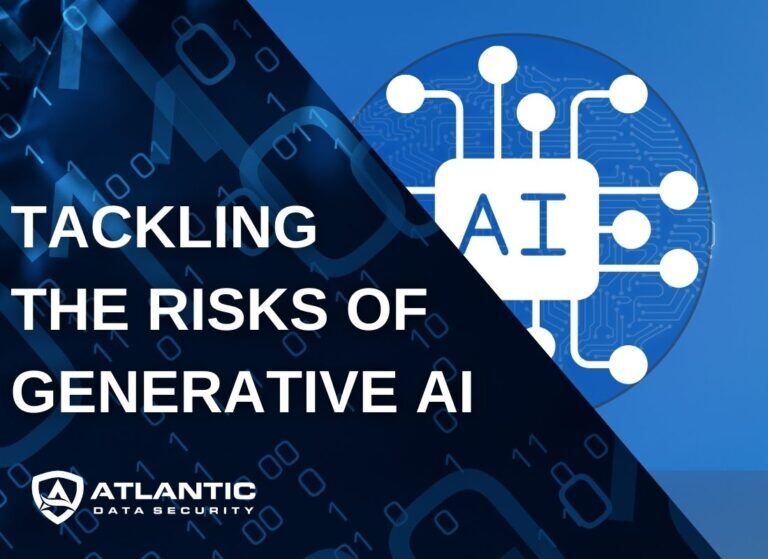Are we unknowingly opening Pandora’s box with AI (Artificial Intelligence) in our businesses? Recently, Atlantic Data Security teamed up with Fortra for an insightful webinar exploring this very question.
What are the immediate risks AI poses to organizations? From reputational damages due to missteps in AI applications, to the more insidious threat of data loss, we explore how AI, a tool with immense potential, can also be a source of significant vulnerability. We aim to highlight these risks and offer high-level recommendations, providing a springboard for further exploration.
 Understanding the AI Risks Confronting Organizations
Understanding the AI Risks Confronting Organizations
AI’s integration into business operations is becoming increasingly commonplace. However, this integration has its risks, particularly in terms of security. While AI offers unprecedented efficiency and capability enhancements, it also opens new vulnerabilities. Understanding these risks is the first step in developing effective mitigation strategies, ensuring that AI becomes an asset rather than a liability.
Reputational Risks and AI:
The use of AI in business practices can sometimes lead to unintended reputational risks. An example of such a scenario is when AI-generated content is misused, reflecting poorly on the company. For instance, consider a lawyer using an AI tool like ChatGPT for drafting court filings. If the AI fails to grasp the nuances of legal language or context, it can result in filings that are inaccurate or inappropriate, damaging the law firm’s reputation. These situations underscore the need for caution and oversight when integrating AI into professional practices. Firms must be vigilant in monitoring AI outputs, ensuring that they align with the company’s standards and the professional integrity expected in their industry.
Data Loss Through AI Use:
AI tools often require access to large datasets to learn and make decisions. This requirement raises significant concerns about data security, particularly when sensitive information is involved. A notable example is the incident involving Samsung, where employees uploaded confidential code to ChatGPT. Often unknowingly, employees may expose sensitive information to AI systems, which then feed that data into large training datasets controlled by the AI program creator. This type of data loss can be subtle and particularly dangerous. It highlights the need for stringent controls and policies regarding what data can be fed into AI systems. It emphasizes the importance of robust security measures to safeguard against such accidental data exposure.
Strategizing Against AI-Induced Security Threats:
As organizations increasingly integrate AI into their operations, the need for effective strategies to mitigate AI-induced security risks becomes crucial. The challenge lies in balancing AI’s benefits with its potential threats. Strategies such as implementing a blanket ban on AI tools, utilizing Data Loss Prevention (DLP) technologies, and cultivating employee awareness, offer different advantages and challenges. Understanding these can help organizations tailor their AI use policies to control AI-related risks more effectively.
Block Everything: The Zero-Tolerance Approach
One straightforward strategy to counter AI-induced risks is to prohibit the use of AI tools altogether. This approach, often seen as the simplest and most effective, minimizes the risk by eliminating the source. But it’s a double-edged sword. While it prevents potential AI-related security breaches, it also hampers the adoption of innovative technologies that could drive business growth and efficiency. In industries where AI is rapidly becoming a competitive necessity, a blanket ban could lead to a significant disadvantage. Therefore, while effective in mitigating risks, this approach requires careful consideration of its broader business implications.
Implement DLP:
Data Loss Prevention (DLP) technologies offer a more nuanced approach to managing AI risks. DLP solutions can detect and prevent sensitive information from being inadvertently exposed or misused by monitoring and controlling data interaction with AI models. For instance, a DLP system could flag and restrict the upload of confidential documents into an AI tool, thus preventing potential data breaches. This approach allows organizations to leverage AI’s benefits while still maintaining a strong hold on data security. It requires investment in the right technology and infrastructure but provides a balanced solution that addresses security concerns without stifling innovation.
Cultivate Employee Awareness:
The most crucial element of ensuring secure use of AI is cultivating a culture of awareness and responsibility among employees. This involves developing comprehensive training programs and policies that educate staff about the potential risks of AI tools and the best practices for their safe use. Employees should understand the types of data that are risky to input into AI systems and the consequences of data breaches. Regular training sessions, updated guidelines, and clear communication channels can help build a technologically adept and security-conscious workforce. This approach mitigates risk and fosters an environment where employees are partners in the organization’s cybersecurity efforts.

Conclusion
As we navigate the evolving landscape of artificial intelligence in business, it’s clear that AI brings a mix of transformative opportunities and novel security risks. This blog has outlined the immediate risks that AI poses, such as reputational damage and data loss, and has explored strategic responses to these emerging challenges, including the implementation of blanket bans, the utilization of Data Loss Prevention (DLP) technologies, and the cultivation of employee awareness.
The key takeaway is that while AI can be a powerful tool for innovation and efficiency, its integration into business operations must be approached with caution and foresight. Organizations must be proactive in understanding the potential risks and implementing comprehensive mitigation strategies. This involves balancing, embracing technological advancement, and safeguarding against its vulnerabilities.
For a deeper dive into these topics and more insights into how AI is reshaping the cybersecurity landscape, we invite you to watch our recent webinar in collaboration with Fortra. This webinar offers valuable perspectives and expert opinions on staying ahead of AI-generated security risks. By staying informed and vigilant, we can harness the full potential of AI while ensuring our digital ecosystems remain secure and resilient.

